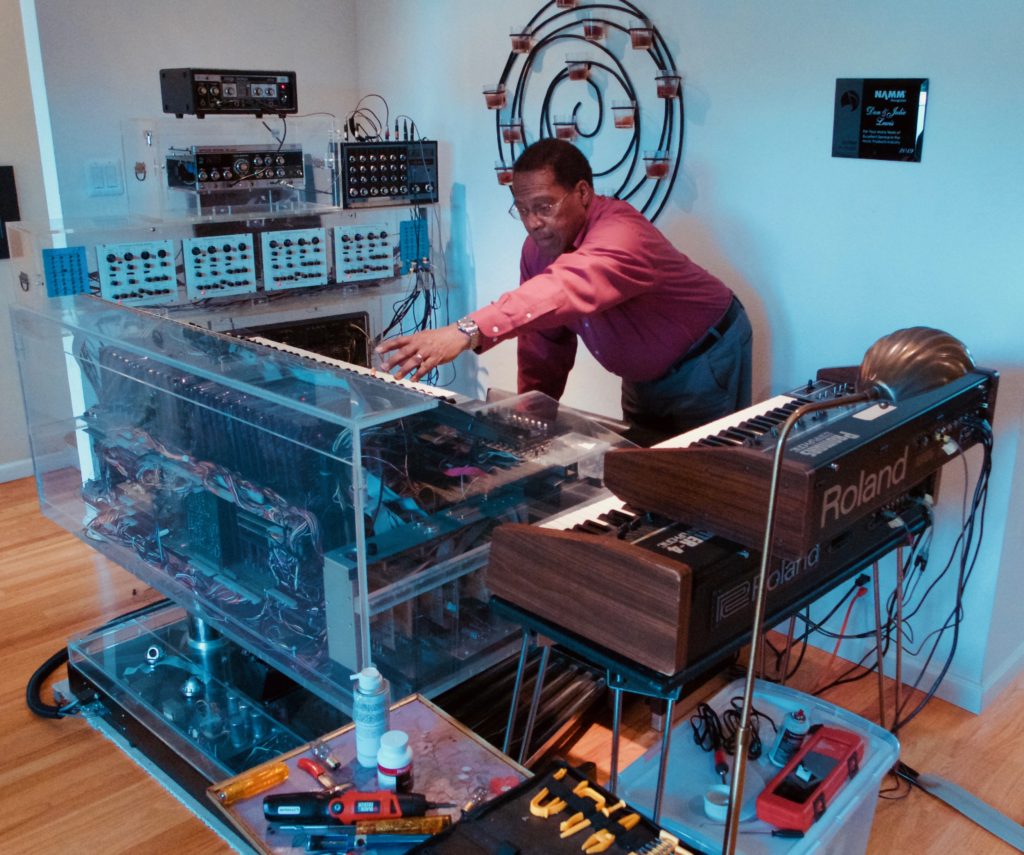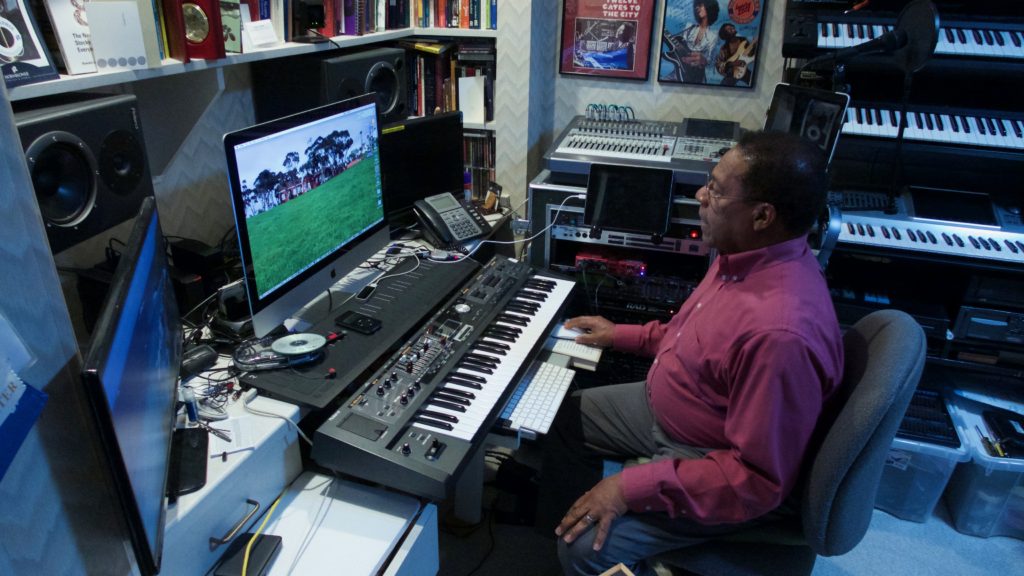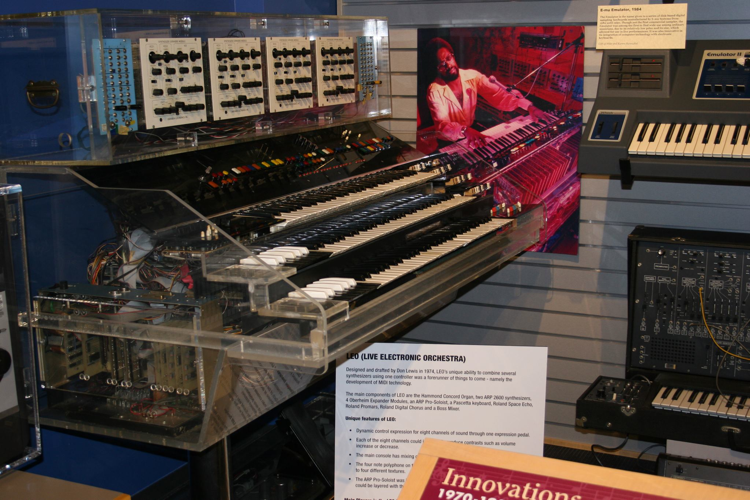
What do you call a guy who’s been the sound designer/musician for the likes of Michael Jackson, Quincy Jones and the Beach Boys? Add to his resume that he is a multi-instrumentalist, vocalist and has scored and produced music for television, films and commercials.
He’s also the inventor of LEO (Live Electronic Orchestra) and a consultant on several groundbreaking music products that have earned him the right to be called a musical pioneer. I’m referring to Don Lewis, who is the subject of an independently-produced documentary on his life, “The Ballad of Don Lewis”, that will be released soon. All this aside, since he lives here in the East Bay, we call him our neighbor.

Don recently released an album of gospel music, “Amazing Voyage”, on the Music In the Air (MITA) label and available through Blue Coast Music. You can read my review of the album here, but writing a review wasn’t really enough for me. I wanted to meet the man who made this awe-inspiring album.
So, Jack and I were delighted to be able to visit Don and his wife, Julie, recently in his studio in Pleasanton, CA, about 45 minutes from our house. There was an instant connection, and when we left, we knew we had made two new friends. As we talked, it was interesting to see pivotal moments in his life that charted the path to where he is today.
First Steps for a Musical Pioneer
“I started out on the ukulele,” Don said, “and you learn chords, which helped when I learned to play church music on an organ.” But from childhood, Don also liked to build electronic things; for example, he went from making a crystal diode radio, his first project, to a working television in about a year.
His school had an electronics class with a lab. For his senior project, he wanted to make an electronic organ, and he had two faculty members who volunteered to fund his project because they were so sure he could do it. Ultimately, he put the organ on the back burner for that year, but the project followed him to college. Believe it or not, the first assignment in his English class was to write a research paper. Yes, he wrote about how to design an electronic organ.
“The school library was not where I got my sources. I had to write all over this country and even to England to get source materials,” Don said. One of his sources was Alan Douglas, who helped to design the famous Allen organs.
Other Early Influences
From college, Don went into the Air Force and was stationed in Roswell, New Mexico. Again, this was another stepping stone on his path as an inventor. He was trained as a nuclear weapons specialist and then worked for Honeywell building test instruments for the government. “We had all of the integrated circuits that no one had commercially yet.”
With this really good introduction to electronics in the early ‘60s, Don says there were two more pivotal points that influenced his career at about this same time. The first was hearing “Saint-Saëns’ Organ Symphony”. “It just transformed me. The sound of the orchestra, those two pianos, the harp, the pipe organ, and all of that going on at the same time.” And, the second was hearing “Switched On Bach” on the car radio. He claims he was so excited that he nearly wrecked his car.

While working at Honeywell in the daytime, Don began his first professional musician job at an upscale restaurant in Denver, Mr. G’s. What he played was a rather ’souped up’ Seeburg Organ with acoustic suspension speakers inside the organ. After leaving Honeywell, he worked for the local Hammond dealer during the day and began playing night clubs in the evenings on his new Hammond X-77. Because the X-77 didn’t have rhythm, Don added the Acetone FR-2L, interfacing it through the organ expression pedal to allow him to add accents to the rhythms with his foot as he was playing.
When one of the executives of the Hammond company came to Denver, Don’s boss took him to the restaurant to meet Don, which ultimately led to Don going to his first National Association of Music Merchants (NAMM) Show in 1969 to play for the Hammond Organ Company followed by a three-week tour in Japan for Hammond. Don also integrated ARP synthesizers and continued to use the Acetone Rhythm Unit with his Hammond for his performances at NAMM and in clubs.
As Don explains, “Synthesizers to me are like the difference in art between a realist and an impressionist. Synthesizers are more like the impressionist.” And while synthesizers began to multiply during the early 70s, he says they were hard to play because there was no way to control the output of multiple synthesizers when played together. That’s why he invented LEO. It’s basically a central console that works like an organ to enable multiple synthesizers to play together.
Introducing LEO
While we were there, we got to hear Don play LEO, which was recently moved from the Museum of Making Music in Carlsbad, CA to Don’s studio. LEO is built from an assortment of parts that starts with the first solid-state organ Hammond ever made, the Concorde, two ARP 2600’s and four Oberheim SEM’s. See the full list below for what makes up this amazing instrument.

LEO is enclosed in plexiglass cases that were designed by Don and custom built. The pedestal the unit sits on was from an X-66 Don saw at the Hammond Organ Company that was destined to be crushed as surplus. A custom-built pair of RTR speakers drive the system with 19 drivers, 9 tweeters, 6 10-inch line speakers and 2 squawkers.
We weren’t sure what was more impressive, the musicality of LEO or watching Don’s feet and fingers as they flew across pedals and keys to play the amazing sounds we were hearing.
It’s an understatement to say that we are looking forward to seeing what’s next for Don in his musical journey. We’re really looking forward to seeing the documentary. For now, though, we are very thankful that our paths have crossed. And, I’m sure we will be back in Pleasanton to hear more sometime soon.
A List of LEO’s Components:
- Hammond Concorde
- (4) Oberheim Expander Module (SEM)
- ARP Pro-soloist
- (2) ARP 2600’s
- Roland Jupiter 4
- Roland Jupiter 4
- Roland Promars
- Roland Space Echo
- Roland Digital Chorus
- Roland VP-330 vocoder
- Roland TR-808
- Hammond X-66 pedestal
- Pascetta Polyphonic Keyboard
- Roland 8 channel mixer


Dear Don and family and friends:
I just met you through your videos recommended from a link in an email from the MIDI Association.
I just heard that you died. Sorry to hear this, but I am sure that you are Praising God up there in Heaven!!! Thank you for all you have done with music and Synths and linking multiple synths together. Very inspiring. Thank you to all who helped along the way and to the interviewers and posters who shared your talent and stories with us.
Tom Anderson in Toronto Canada.